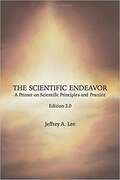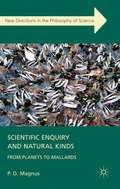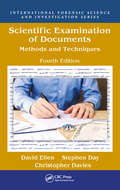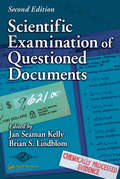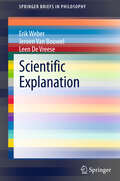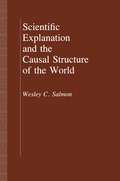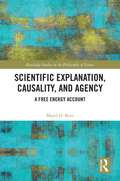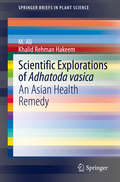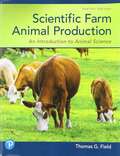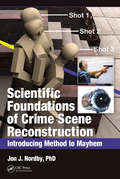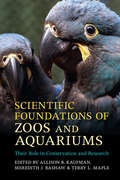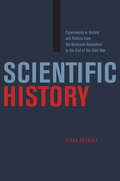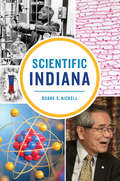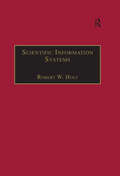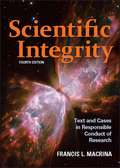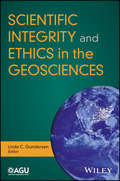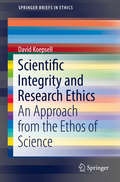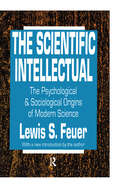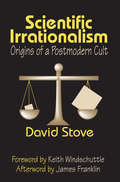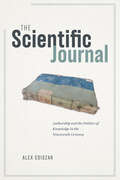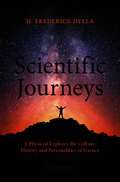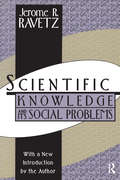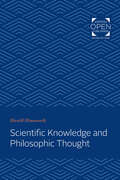- Table View
- List View
The Scientific Endeavor: A Primer on Scientific Principles and Practice
by Jeffrey Lee"The Scientific Endeavor" is an introduction to what science is and how it is done. Many college courses are good at presenting particular disciplines (Biology, Chemistry, etc.), but not the details of science itself. Science literacy for educated citizens and for professional scientists requires an understanding of science itself. Written at an introductory college level, this book provides on overview of what science is, the philosophy of science, how research is done, how scientists interact, ethics and misconduct, scientific thinking, and pseudoscience. It has been used as a supplementary textbook in introductory science classes, as the main text in classes about science, and as background reading to spark discussions in advanced undergraduate and graduate courses.
Scientific Enquiry and Natural Kinds
by P. D. MagnusSome scientific categories seem to correspond to genuine features of the world and are indispensable for successful science in some domain; in short, they are natural kinds . This book gives a general account of what it is to be a natural kind and puts the account to work illuminating numerous specific examples.
Scientific Examination of Documents: Methods and Techniques, Fourth Edition (International Forensic Science And Investigation Ser.)
by David Ellen Stephen Day Christopher DaviesRevised and expanded to reflect the most recent innovations in the field, The Scientific Examination of Documents, Fourth Edition is a handy, accessible volume detailing current best-practices for forensic document examination. Since the first edition published in 1989, there have been drastic changes in the field of forensic document examination—both from the use of the analytic techniques available to the professional examiner—and the changes to technology in office and printing equipment and inks. The purpose of analyzing any material used in the production of a questioned document, such as an ink or a piece of paper, is to compare it with another material elsewhere in the questioned document itself—or on another document—to determine whether or not they share a common origin. There may also be a need to provide information for the investigator about the possible origins of the document. This latest edition reflects the myriad changes and advances that have occurred in the last 10 to 15 years. Topics covered include: current thinking on handwriting interpretation; accidental and deliberate modification of handwriting; the proper collection of samples; a discussion of shredded documents; professional accreditation standards, qualifications, and training; and modern digital imaging and analysis of documents and handwriting utilizing software and imaging, including reconstruction of an image from erasures, obliteration and other document altering methods. A new section addresses cognitive bias and Chapter 8 is completely updated to cover the advances in print and photocopied documents, based on current technology, and analytical developments in the comparison of such documents. Key features: Discusses issues regarding handwritten, photocopied, and printed documents—including inkjet versus digital printing Presents the advances and capabilities modern office fax, photocopy, and printing technologies—and implications for document examination Details and reinforces the importance of ensuring proper scientific methods during an examination Addresses current Raman spectroscopy, UV-VIS, mass spectroscopy, and SEM analysis techniques Highlights the importance, and implications, of biological and fingerprint evidence from documents that can be collected, examined, and utilized in a case The Scientific Examination of Documents, Fourth Edition serves as an invaluable resource to established professionals, those just entering the field, and legal and investigative professionals outside the discipline who have a professional interest dealing with questioned documents in the course of their work.
Scientific Examination of Questioned Documents (Forensic and Police Science Series)
by Michael S. BisesiConsidered the forensic document examiner's bible, Scientific Examination of Questioned Documents is an authoritative and comprehensive reference that focuses on the pertinent advancements made within the field. This newest edition presents the qualifications necessary for a well-trained examiner and details the most up-to-date methodologies used i
Scientific Explanation
by Jeroen Van Bouwel Leen De Vreese Erik WeberWhen scientist investigate why things happen, they aim at giving an explanation. But what does a scientific explanation look like? In the first chapter (Theories of Scientific Explanation) of this book, the milestones in the debate on how to characterize scientific explanations are exposed. The second chapter (How to Study Scientific Explanation?) scrutinizes the working-method of three important philosophers of explanation, Carl Hempel, Philip Kitcher and Wesley Salmon and shows what went wrong. Next, it is the responsibility of current philosophers of explanation to go on where Hempel, Kitcher and Salmon failed. However, we should go on in a clever way. We call this clever way the pragmatic approach to scientific explanation and clarify briefly what this approach consists in. The third chapter (A Toolbox for Describing and Evaluating Explanatory Practices) elaborates the pragmatic approach by presenting a toolbox for analysing scientific explanation. In the last chapter (Examples of Descriptions and Evaluations of Explanatory Practices) the approach is illustrated with real-life examples of scientists aiming at explaining. This book can be used as a textbook for intermediate philosophy of science courses and is also valuable as "suggested reading" for introductory courses in philosophy of science. The way the book is set up makes it an excellent study and research guide for advanced (MA and PhD) students that work on the topic of scientific explanation. Finally, it is a handy source and reference book for senior researchers in the field of scientific explanations and - more generally - for all philosophers of science.
Scientific Explanation and the Causal Structure of the World
by Wesley C. SalmonThe philosophical theory of scientific explanation proposed here involves a radically new treatment of causality that accords with the pervasively statistical character of contemporary science. Wesley C. Salmon describes three fundamental conceptions of scientific explanation--the epistemic, modal, and ontic. He argues that the prevailing view (a version of the epistemic conception) is untenable and that the modal conception is scientifically out-dated. Significantly revising aspects of his earlier work, he defends a causal/mechanical theory that is a version of the ontic conception. Professor Salmon's theory furnishes a robust argument for scientific realism akin to the argument that convinced twentieth-century physical scientists of the existence of atoms and molecules. To do justice to such notions as irreducibly statistical laws and statistical explanation, he offers a novel account of physical randomness. The transition from the "reviewed view" of scientific explanation (that explanations are arguments) to the causal/mechanical model requires fundamental rethinking of basic explanatory concepts.
Scientific Explanation, Causality, and Agency: A Free Energy Account (Routledge Studies in the Philosophy of Science)
by Majid D. BeniThis book draws on advances in computational neuroscience and theoretical biology to provide a clear and accessible agentive account of the nature of causality and scientific explanations.Instead of attempting to establish the elements of scientific explanation, such as causality, in a reality unadulterated by a human perspective, this book relies on scientific facts about cognition to describe the structure of agency from a distinctly human perspective. The book draws on the Free Energy Principle to reinforce the agency theory of causality and extend it to an account of explanation as well. This principle not only provides a theoretical account of how self-organising systems engage with the causal structure of the environment, but it also offers a viable notion of agency and is compatible with the projectivist aspects of the agency theory.Scientific Explanation, Causality, and Agency will appeal to researchers and advanced students working in philosophy of science, philosophy of cognitive science, epistemology, computational neuroscience, and theoretical biology.
The Scientific Exploration of Venus
by Fredric W. TaylorVenus is the brightest 'star' in the night sky and it has been observed since ancient times. Often dubbed Earth's 'twin', it is the planet most similar to the Earth in size, mass and composition. There the similarity ends: Venus is shrouded by a dense carbon dioxide atmosphere, its surface is dominated by thousands of volcanoes and it lacks a protective magnetic field to shield it from energetic solar particles. So why isn't Venus more like Earth? In this book, a leading researcher of Venus addresses this question by explaining what we know through our investigations of the planet. Venus presents an intriguing case study for planetary astronomers and atmospheric scientists, especially in light of the current challenges of global warming, which supports, and potentially threatens, life on Earth. Scientifically rigorous, yet written in a friendly non-technical style, this is a broad introduction for students, and astronomy and space enthusiasts.
Scientific Explorations of Adhatoda vasica: An Asian Health Remedy (SpringerBriefs in Plant Science)
by M. Ali Khalid Rehman HakeemNatural remedies play an important role in curing ailments that happen by chance or adoptively. Adhatoda vasica is a natural Asian remedy that has the potential to treat respiratory disorders, among others. While existing literature does exist on this medicinal plant, it can be cumbersome to sort through for information relevant to academics, research, and practice. This work reframes and consolidates information on Adhatoda vasica so that it is easier to approach through academic, research, and practitioner perspectives.
Scientific Farm Animal Production: An Introduction To Animal Science
by Robert Taylor Thomas FieldScientific Farm Animal Production: An Introduction to Animal Scienceis the single best integrated resource combining a strong disciplinary focus with best practices in production for the major livestock and poultry industries. A detailed study of eight primary livestock industries is examined along with market forces affecting demand across the supply chain as well as related societal issues and challenges. The 12th edition has updated industry data and insights, improved graphics and images, and simplified material adding greater meaning for students without a livestock production background.
Scientific Foundations of Crime Scene Reconstruction: Introducing Method to Mayhem
by Ph.D., Jon NordbyPhilosophers of science have long used reconstructive reasoning to develop historical explanations covering the origins of natural phenomenon. The application of the scientific method is a powerful tool for solving crimes through reconstruction of the events. Scientific Foundations of Crime Scene Reconstruction: Introducing Method to Mayhem demonst
Scientific Foundations of Engineering
by Mcknight Stephen W. Christos ZahopoulosProviding an overview of the foundations of engineering from a fundamental scientific and physical perspective, this book reinforces the basic scientific and mathematical principles which underpin a range of engineering disciplines and applications. It covers the basics of physics, including quantum physics, as well as some key topics in chemistry, making it a valuable resource for both students and professionals looking to gain a more coherent and interdisciplinary understanding of engineering systems. Throughout, the focus is on common features of physical systems (such as mechanical and electronic resonance), showing how the same underlying principles apply to different disciplines. Problems are provided at the end of each chapter including conceptual questions and examples to demonstrate the practical application of fundamental scientific principles. These include real-world examples, which are solvable using computational packages such as MATLAB.
Scientific Foundations of Zoos and Aquariums: Their Role in Conservation and Research
by Allison B. Kaufman Meredith J. Bashaw Terry L. MapleIn the modern era, zoos and aquariums fight species extinction, educate communities, and advance learning of animal behaviour. This book features first person stories and scientific reviews to explore ground breaking projects run by these institutions. Large-scale conservation initiatives that benefit multiple species are detailed in the first section, including critical habitat protection, evidence-based techniques to grow animal populations and the design of community education projects. The second section documents how zoos use science to improve the health and welfare of animals in captivity and make difficult management decisions. The section on saving species includes personal tales of efforts to preserve wild populations through rehabilitation, captive breeding, reintroduction, and public outreach. The concluding section details scientific discoveries about animals that would have been impossible without the support of zoos and aquariums. The book is for animal scientists, zoo professionals, educators and researchers worldwide, as well as students of zookeeping and conservation.
Scientific History: Experiments in History and Politics from the Bolshevik Revolution to the End of the Cold War
by Elena AronovaIncreasingly, scholars in the humanities are calling for a reengagement with the natural sciences. Taking their cues from recent breakthroughs in genetics and the neurosciences, advocates of “big history” are reassessing long-held assumptions about the very definition of history, its methods, and its evidentiary base. In Scientific History, Elena Aronova maps out historians’ continuous engagement with the methods, tools, values, and scale of the natural sciences by examining several waves of their experimentation that surged highest at perceived times of trouble, from the crisis-ridden decades of the early twentieth century to the ruptures of the Cold War. The book explores the intertwined trajectories of six intellectuals and the larger programs they set in motion: Henri Berr (1863–1954), Nikolai Bukharin (1888–1938), Lucien Febvre (1878–1956), Nikolai Vavilov (1887–1943), Julian Huxley (1887–1975), and John Desmond Bernal (1901–1971). Though they held different political views, spoke different languages, and pursued different goals, these thinkers are representative of a larger motley crew who joined the techniques, approaches, and values of science with the writing of history, and who created powerful institutions and networks to support their projects. In tracing these submerged stories, Aronova reveals encounters that profoundly shaped our knowledge of the past, reminding us that it is often the forgotten parts of history that are the most revealing.
Scientific Indiana
by Duane S. NickellScientists who lived, worked or were educated in the Hoosier State have made fundamental contributions to astronomy, biology, chemistry and physics. Astronomer Vesto Slipher discovered that almost all other galaxies were moving away from our own Milky Way Galaxy. Biologist Alfred Kinsey was a pioneer in the field of human sexuality. Chemist Harold Urey discovered deuterium and worked on the Manhattan Project. And physicist Edward Purcell discovered nuclear magnetic resonance, the basis for MRI, one of the most significant medical advances in a century. Scientists with Indiana connections have also been awarded a dozen Nobel Prizes. Hoosier science teacher Duane S. Nickell offers a glimpse into the lives of seventeen scientific heroes from Indiana.
Scientific Information Systems
by Robert W. HoltSafety critical jobs in fields such as aviation and nuclear power plants require a careful and comprehensive analysis of all factors relevant to critical job performance. Understanding how these factors uniquely and in combination, affect performance requires interconnecting a job performance database with several other information databases. The scientific method is necessary to ensure information quality; to solve problems or project trends; and to correctly evaluate changes in selection, training, performance evaluation, the person-machine interface, or team dynamics. Combining the scientific method with the construction, validation and use of the information databases results in a Scientific Information System (SIS), which joins practical utility with powerful evauations of relevant theories. This book discusses how to blend scientific methods with the broad capabilities of computer database information systems. This synthesis will aid anyone who is trying to explain, predict, or change the behavior of a complex system involving humans. Whilst developed from research on information systems in the aviation industry, the principles and methods are universal and the book provides conceptual guidance for the construction and use of such systems in other domains. The examples clarify the advantages of this type of information system and the enormous potential power for understanding a target system completely and accurately.
Scientific Integrity: Text and Cases in Responsible Conduct of Research (ASM Books)
by Francis MacrinaThis widely adopted textbook provides the essential content and skill-building tools for teaching the responsible conduct of scientific research. Scientific Integrity covers the breadth of concerns faced by scientists: protection of animal and human experimental subjects, scientific publication, intellectual property, conflict of interest, collaboration, record keeping, mentoring, and the social and ethical responsibilities of scientists. Learning activities and resources designed to elucidate the principles of Scientific Integrity include Dozens of highly relevant, interactive case studies for discussion in class or online Numerous print and online resources covering the newest research guidelines, regulations, mandates and policies Discussion questions, role-playing exercises, and survey tools to promote critical thought Documents including published rules of conduct, sample experimentation protocols, and patent applications The new edition of Scientific Integrity responds to significant recent changes—new mandates, policies, laws, and other developments—in the field of responsible conduct of research. Dr. Macrina plants the seeds of awareness of existing, changing, and emerging standards in scientific conduct and provides the tools to promote critical thinking in the use of that information. Scientific Integrity is the original turnkey text to guide the next generations of scientists as well as practicing researchers in the essential skills and approaches for the responsible conduct of science.
Scientific Integrity and Ethics in the Geosciences
by Linda C. GundersenScience is built on trust. The assumption is that scientists will conduct their work with integrity, honesty, and a strict adherence to scientific protocols. Written by geoscientists for geoscientists, Scientific Integrity and Ethics in the Geosciences acquaints readers with the fundamental principles of scientific ethics and shows how they apply to everyday work in the classroom, laboratory, and field. Resources are provided throughout to help discuss and implement principles of scientific integrity and ethics. Volume highlights include: Examples of international and national codes and policies Exploration of the role of professional societies in scientific integrity and ethics References to scientific integrity and ethics in publications and research data Discussion of science integrity, ethics, and geoethics in education Extensive coverage of data applications Scientific Integrity and Ethics in the Geosciences is a valuable resource for students, faculty, instructors, and scientists in the geosciences and beyond. It is also useful for geoscientists working in industry, government, and policymaking.
Scientific Integrity and Research Ethics
by David KoepsellThis book is an easy to read, yet comprehensive introduction to practical issues in research ethics and scientific integrity. It addresses questions about what constitutes appropriate academic and scientific behaviors from the point of view of what Robert Merton called the "ethos of science. " In other words, without getting into tricky questions about the nature of the good or right (as philosophers often do), Koepsell's concise book provides an approach to behaving according to the norms of science and academia without delving into the morass of philosophical ethics. The central thesis is that: since we know certain behaviors are necessary for science and its institutions to work properly (rather than pathologically), we can extend those principles to guide good behaviors as scientists and academics. The Spanish version of this book was commissioned by the Mexican National Science Foundation (CONACyT) and is being distributed to and used by Mexican scientists in a unique, national plan to improve scientific integrity throughout all of Mexico. Available now in English, the examples and strategies employed can be used throughout the English speaking research world for discussing issues in research ethics, training for scientists and researchers across disciplines, and those who are generally interested in ethics in academia.
The Scientific Intellectual: The Psychological & Sociological Origins of Modern Science
by Lewis S. FeuerThe birth of modern science was linked to the rise in Western Europe of a new sensibility, that of the scientific intellectual. Such a person was no more technician, looking at science as just a job to be done, but one for whom the scientific stand-point is a philosophy in the fullest sense. In The Scientific Intellectual, Lewis S. Feuer traces the evolution of this new human type, seeking to define what ethic inspired him and the underlying emotions that created him.Under the influence of Max Weber, the rise of the scientific spirit has been viewed by sociologists as an offspring of the Protestant revolution, with its asceticism and sense of guilt acting as causative agents in the rise of capitalism and the growth of the scientific movement. Feuer takes strong issue with this view, pointing out how it is at odds with what we know of the psychological conditions of modern societies making for human curiosity and its expression in the observation of and experiment with nature.Feuer shows that wherever a scientific movement has begun, it has been based on emotions that issue in what might be called a hedonist-libertarian ethic. The scientific intellectual was a person for whom science was a 'new philosophy,' a third force rising above religious and political hatreds, seeking in the world of nature liberated vision, a intending to use and enjoy its knowledge. In his new introduction to this brilliantly readable volume, Professor Feuer reviews the book's critical reception and expands the scope of the original edition to include fascinating discussions of Francis Bacon, Thomas Edison, Charles Darwin, Thomas Hardy, and others. The Scientific Intellectual will be of interest to scientists and intellectual historians.
Scientific Irrationalism: Origins of a Postmodern Cult
by David StoveLittle known outside his native Australia, David Stove was one of the most illuminating and brilliant philosophical essayists of his era. A fearless attacker of intellectual and cultural orthodoxies, Stove left powerful critiques of scientific irrationalism, Darwinian theories of human behavior, and philosophical idealism.Since its inception in the 1940s, the field of science studies, originally intended to bridge the gap between science and the humanities, has been the center of controversy and debate. The most notable figures in this debate are Thomas Kuhn and Karl Popper. In Scientific Irrationalism, now available in paperback, David Stove demonstrates how extravagant has been the verbiage wasted on this issue and how irrational the combatants have been. He shows that Kuhn and Popper share considerable common ground. Stove argues that the problems all reside in the reasoning of the critics. He identifies the logical mistakes and conceptual allusions made by Kuhn and Popper and their supporters, as well as their collective dependency on a single argument made by the philosopher of the Scottish Enlightenment, David Hume. He then demonstrates how little potency that argument actually has for the claims of science.In his foreword, Keith Windschuttle explains the debate surrounding the field of science studies and explores David Stove's contribution as well as his lack of recognition. In an afterword, James Franklin discusses reactions to Stove's work.
The Scientific Journal: Authorship and the Politics of Knowledge in the Nineteenth Century
by Alex CsiszarNot since the printing press has a media object been as celebrated for its role in the advancement of knowledge as the scientific journal. From open communication to peer review, the scientific journal has long been central both to the identity of academic scientists and to the public legitimacy of scientific knowledge. But that was not always the case. At the dawn of the nineteenth century, academies and societies dominated elite study of the natural world. Journals were a relatively marginal feature of this world, and sometimes even an object of outright suspicion.The Scientific Journal tells the story of how that changed. Alex Csiszar takes readers deep into nineteenth-century London and Paris, where savants struggled to reshape scientific life in the light of rapidly changing political mores and the growing importance of the press in public life. The scientific journal did not arise as a natural solution to the problem of communicating scientific discoveries. Rather, as Csiszar shows, its dominance was a hard-won compromise born of political exigencies, shifting epistemic values, intellectual property debates, and the demands of commerce. Many of the tensions and problems that plague scholarly publishing today are rooted in these tangled beginnings. As we seek to make sense of our own moment of intense experimentation in publishing platforms, peer review, and information curation, Csiszar argues powerfully that a better understanding of the journal’s past will be crucial to imagining future forms for the expression and organization of knowledge.
Scientific Journeys: A Physicist Explores the Culture, History and Personalities of Science
by H. Frederick DyllaThis collection of essays traces a scientific journey bookmarked by remarkable mentors and milestones of science. It provides fascinating reading for everyone interested in the history, public appreciation, and value of science, as well as giving first-hand accounts of many key events and prominent figures. The author was one of the “sputnik kids” growing up in the US at the start of the space age. He built a working laser just two years after they were first invented, an experience that convinced him to become a physicist. During his 50-year career in physics, many personalities and notable events in science and technology helped to form his view of how science contributes to the modern world, including his conviction that the impact of science can be most effective when introduced within the context of the humanities - especially history, literature and the arts.From the Foreword by former U.S. Congressman, Rush D. Holt: In this volume, we have the wide-ranging thoughts and observations of Fred Dylla, an accomplished physicist with an engineer’s fascination for gadgets, a historian’s long perspective, an artist’s aesthetic eye, and a teacher’s passion for sharing ideas. Throughout his varied career [...] his curiosity has been his foremost characteristic and his ability to see the connection between apparently disparate things his greatest skill. [...] Here he examines the roots and growth of innovation in examples from Bell Laboratories, Edison Electric Light Company, and cubist painter Georges Braque. He considers the essential place of publishing in science, that epochal intellectual technique for learning how the world works. He shows the human enrichment and practical benefits that derive from wise investments in scientific research, as well as the waste resulting from a failure to embrace appropriate technologies.
Scientific Knowledge and Its Social Problems
by Jerome R. RavetzScience is continually confronted by new and difficult social and ethical problems. Some of these problems have arisen from the transformation of the academic science of the prewar period into the industrialized science of the present. Traditional theories of science are now widely recognized as obsolete. In Scientific Knowledge and Its Social Problems (originally published in 1971), Jerome R. Ravetz analyzes the work of science as the creation and investigation of problems. He demonstrates the role of choice and value judgment, and the inevitability of error, in scientific research. Ravetz's new introductory essay is a masterful statement of how our understanding of science has evolved over the last two decades.
Scientific Knowledge and Philosophic Thought
by Harold HimsworthOriginally published in 1986. Are there two kinds of problems—the scientific and the philosophic—each requiring different methods for solution? Or are there, rather, two different ways of approaching a problem, each yielding a different answer according to the method used? Biomedical researcher Sir Harold Himsworth urges scientists not to shy away from using scientific methods to grapple with problems traditionally accepted as belonging to the province of philosophy. The difference between science and philosophy lies not in the problems to which they are directed, Himsworth argues, but rather in the methods they use for solving them. To the scientist, a proposition is something to be investigated; to the philosopher, something to be accepted as a basis for thought. Since the development of the scientific method, substantial progress has been made toward mastering problems in the natural environment. If we are ever to attain a degree of control over problems that derive from human activities, Himsworth claims that we only succeed by approaching them in a comparably objective way.
